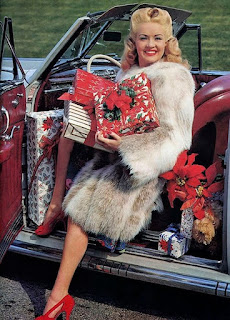After two months of cataloging more than 3,000 of the old 33s, 45s and 78s to CD format, and separating those with a holiday theme, I loaded more than 300 Christmas songs onto a streaming playlist for you to enjoy. In the spirit of of mixtape from years gone by, I found a modern way to bring these songs to the masses for the holiday season, without having to burn hundreds of CDs.
If you are like me, every holiday you tune to a local radio station that traditionally plays the same Christmas songs over and over and over... and yeah, it gets tedious hearing the same recordings every year. Christmas is a time to establish a fond look back through nostalgic vocals and my frustration grows knowing that Gene Autry's rendition of Rudolph, the Red-Nosed Reindeer and Bing Crosby's White Christmas is going to play on rotation... again and again.
What you will hear on this streaming radio station (accessible with a simple click of a button on your computer, iPad, tablet, iPhone, etc.) are vintage Christmas offerings all dated pre-1960 and chances are you haven't heard these renditions. Examples include:
I Want Eddie Fisher for Christmas (1954, Betty Johnson)
Frosty the Snowman (1950, Guy Lombaro and his Orchestra)Santa and the Doodle-Li-Boop (1954, Art Carney)
I Want You for Christmas (1937, Mae Questel as Betty Boop)
All Around the Christmas Tree (1940, Raymond Scott and his New Orchestra)
Barnyard Christmas (1952, Spike Jones and The Bell Sisters)
The Birthday of a King (1949, Judy Garland)
Jingle Bells (1935, Benny Goodman and his Orchestra)
It Happened in Sun Valley (1941, Glenn Miller and his Orchestra)
Christmas in Killarney (1950, Dennis Day with The Mellowmen)
The First Noel (1942, Nelson Eddy and Robert Armbruster's Orchestra)
Let's Start the New Year Right (1942, Bing Crosby)
Hello, Mr. Kringle (1939, Kay Kyser)
Jingle Bells (1934, Ozzie Nelson and his Orchestra, and Harriet Hilliard)
All I Want for Christmas is My Two Front Teeth (1949, Danny Kaye and Patty Andrews)
Yah, Das Ist Ein Christmas Tree (1953, Mel Blanc)
Silent Night (1921, Florence Easton)
Silver Bells (1938, Bob Wills and his Texas Playboys)
Christmas on the Plains (1949, Roy Rogers and Dale Evans)
The Night Before Christmas (1952, Gene Autry and Rosemary Clooney)
O Come, All Ye Faithful (1938, Frances Langford)
Boogie Woogie Santa Claus (1950, Patti Page)
Happy Little Christmas Friend (1953, Rosemary Clooney)
Ol' Saint Nicholas (1949, Doris Day)
A Ride in Santa's Sleigh (1953, Judy Valentine)
Santa Claus is Coming to Town (1934, Harry Reser)
Santa Claus is on His Way (1941, Sammy Kaye and his Orchestra)
Silent Night (1940, Kate Smith)
Suzy Snowflake (1951, Rosemary Clooney)
Auld Lang Syne (1939, Erwin Bendel with Tiny Till and his Orchestra)
Baby, It's Cold Outside (1949, Ella Fitzgerald and Louis Jordan)
Christmas Day (1952, Eddie Fisher)
Meet Me Under the Mistletoe (1941, Dick Roberston)
Merry Christmas Polka (1949, Guy Lombardo and The Andrews Sisters)
I'll Be Home for Christmas (1947, Eddy Howard)
Five Pound Box of Money (1959, Pearl Bailey)
The Man with the Whiskers (1938, Hoosier Hot Shots)
March of the Toys (1939, Tommy Dorsey)
Hark, the Herald Angels Sing (1938, Kenny Baker)
I Want You for Christmas (1937, Russ Morgan)
The Kissing Bridge (1953, The Fontane Sisters and Perry Como)
I Saw Mommy Kissing Santa Claus (1952, Molly Bee)
Here Comes Santa Claus (1949, Doris Day)
I Believe in Santa Claus (1955, The Mills Brothers)
Little Sandy Sleighfoot (1957, Jimmy Dean)
The Man with the Bag (1950, Kay Starr)
Merry Christmas Waltz (1949, Gordon MacRae)
Christmas Alphabet (1954, The McGuire Sisters)
Let It Snow, Let It Snow (1946, Bob Crosby)
I Saw Mommy do the Mombo (1954, Jimmy Boyd)
The Mistletoe Kiss (1948, Primo Scala and The Keynotes)
My Christmas Song for You (1945, Hoagy Carmichael and Martha Mears)
Christmas Night in Harlem (1934, Todd Rollins and his Orchestra)
Among the highlights you will hear "I Want a Television Christmas" by Mindy Carson (which happens to be a 1949 RCA sales promo), the 1953 Christmas Dragnet spoof with Daws Butler and Stan Freberg, a 1953 commercial recording of Amos and Andy's popular "The Lord's Prayer," Basil Rathbone narrating a musical rendition of "Twas the Night Before Christmas" (1942), Bing Crosby's 1942 version of "White Christmas" (not the 1947 re-recording you commonly hear on radio today), Jerry Colonna's 1953 take on "Too Fat for the Chimney," the 1934 version of "Winter Wonderland" performed by Richard Himber (the first recording ever made of that song), and other rarities.
Of the 300 plus recordings, you will no doubt hear the same song (such as "Winter Wonderland" and "The First Noel") performed multiple times but each rendition with a different singer.
Many familiar songs but with unfamiliar renditions from your favorite singers. (Believe me, I will have this radio station playing all day at home, and streaming through my iPhone when I travel during the holiday season.) I hope this musical yule log not only suits your palate, but many of these songs become a favorite of yours.













































